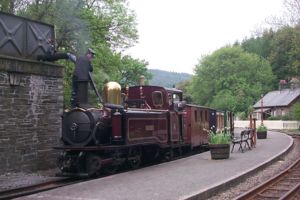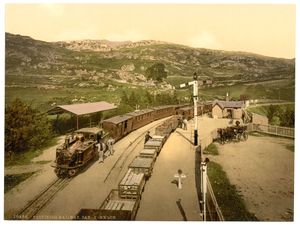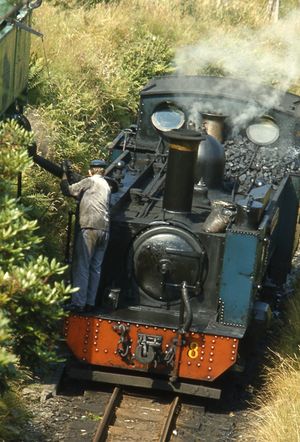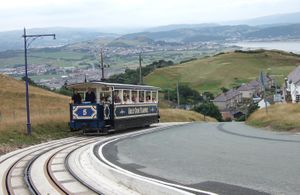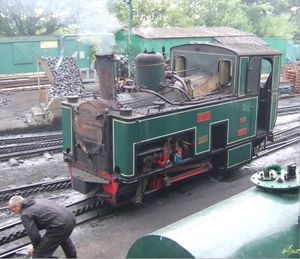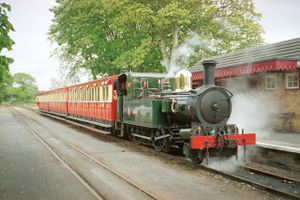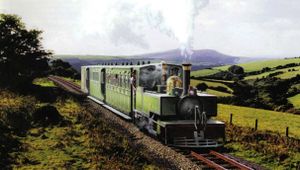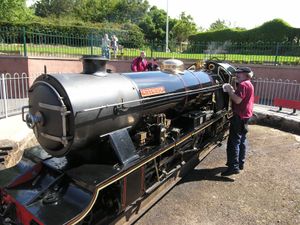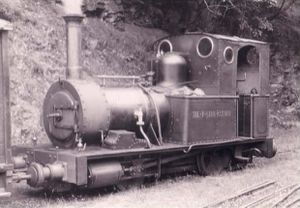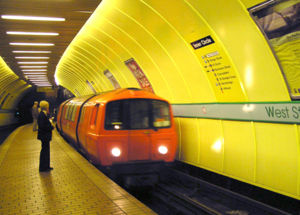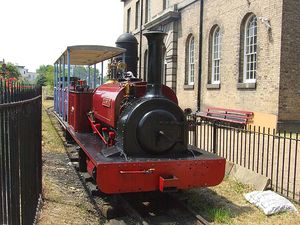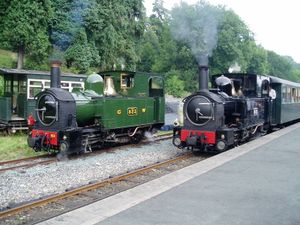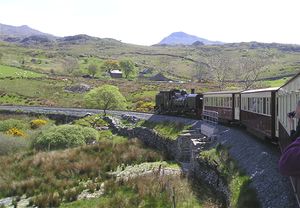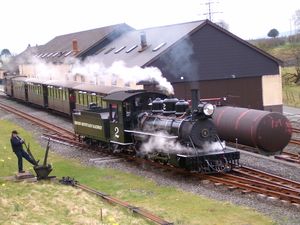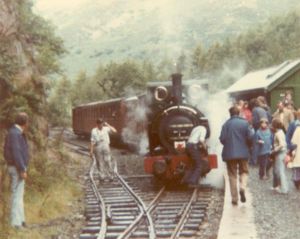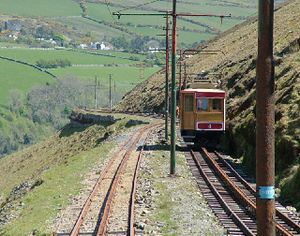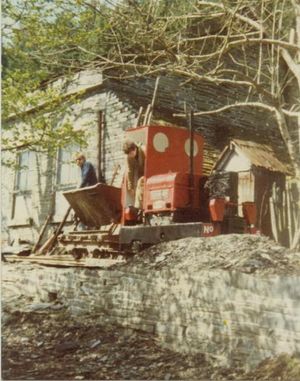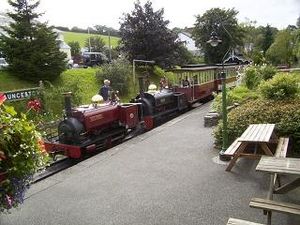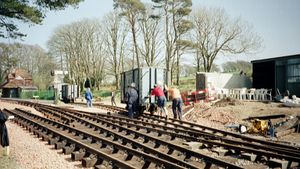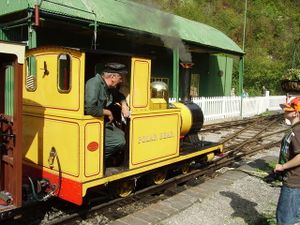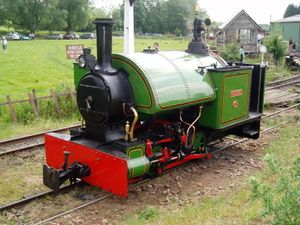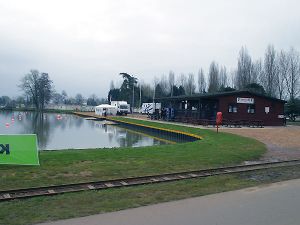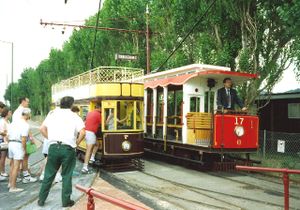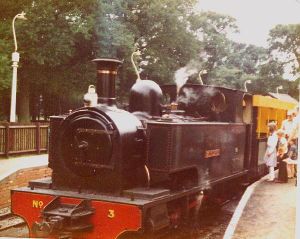British narrow gauge railways
There were more than a thousand British narrow gauge railways ranging from large, historically significant common carriers to small, short-lived industrial railways. Many notable events in British railway history happened on the narrow gauge including the first use of steam locomotives, the first public railway and the first preserved railway.
Contents
History
Early railways: before 1865
The earliest narrow gauge railways were crude wooden trackways used in coal mines to guide wooden tubs. Because of the restricted loading gauge of the tunnels and the need for the tubs to be small enough to be pushed by one man, these railways were almost all narrow gauge. These underground lines often had short above ground sections as well.
After the start of the Industrial Revolution it became possible to create railways with iron tracks and wheels, which reduced the friction involved in moving wagons and made longer horse-hauled trains possible. These could move more material over longer distances, allowing the construction of railways from mines and quarries to transshipment points on rivers, canals and the coast. The earliest narrow gauge railways that were more than simply internal mine or quarry systems were all horse drawn industrial railways of this sort. Prominent examples include the 3 ft 6 in (1067 mm) gauge Little Eaton Gangway of 1793, the 2 ft (610 mm) gauge Llandegai Tramway of 1798 and the 4 ft 2 in gauge Surrey Iron Railway of 1803. The latter was the world's first public railway.
Meanwhile the development of the stationary steam engine was proceeding to the point where early steam locomotives were being proposed. In 1804 Richard Trevithick demonstrated the first locomotive-hauled railway in the world: the 4 ft (1219 mm) gauge Penydarren Tramway in south Wales. Although this first use of locomotives was a limited and short-lived experiment, in 1812 the 4 ft 1 in (1245 mm) gauge Middleton Railway in Leeds became the first in the world to make commercial use of steam haulage.
Steam technology developed rapidly in the early 1800s, allowing smaller locomotives to haul more goods. The horse-drawn Ffestiniog Railway opened in 1836 to connect the slate quarries at Blaenau Ffestiniog with the coastal port of Porthmadog. The traffic on the line quickly grew to the point where the horses could no longer haul the empty slate wagons back to the quarries quickly enough to meet demand. In 1863 steam locomotives were introduced on the 1 ft 111⁄2 in (597 mm) gauge railway, with passenger services following in 1865. This was the first steam operated railway providing both freight and passenger services on such a small gauge, and it proved the model for the introduction of narrow gauge railways across the world.
In 1846 the British Parliament passed the Gauges Act that established 4 ft 8½ in (1435 mm) as the standard gauge for Britain. After the Gauges Act, most of the railway track laid in Great Britain was to standard gauge. However many minor railways, both public and industrial were built to narrower gauges. These lines either followed local traditions or were built in locations where the smaller size of the railway proved more economical or was simply necessary due to physical limitations such as bridges and tunnels.
The boom years: 1865-1900
The success of the Ffestiniog Railway triggered a boom in the construction of narrow gauge railways, not just in Britain but around the world. In the United Kingdom the center of narrow gauge construction was north Wales. The mountains of the north held large quantities of slate and their narrow valleys and steep hillsides meant that the smaller narrow gauge railways were cost effective. The major slate mining regions at Bethesda, Llanberis, Blaenau Ffestiniog and Corris all developed multiple railways to serve the quarries. Some of these lines, like the Ffestiniog Railway, the Corris Railway and the Talyllyn Railway were common carriers, while others like the Penrhyn Quarry Railway and the Padarn Railway were purely industrial lines.
Outside Wales, other industries started to use narrow gauge railways to move freight notably ironstone, limestone, china clay, brick clay and metals. Many common carrier lines were built: all of the railways on the Isle of Man were narrow gauge - mostly 3 ft (914 mm) gauge. A number of railways were built to connect standard gauge railways with smaller towns, including the Southwold Railway, the Wolverton and Stony Stratford Tramway and the famous Lynton and Barnstaple Railway in Devon. These lines allowed communities that did not merit a full railway service to connect to the mainline network at low cost.
The 1880s were the high point of British narrow gauge railways as traffic on many of these lines reached its peak volume and new lines were built across the country.
Decline of the narrow gauge: 1900-1950
In 1896 the Light Railways Act was passed which allowed the construction of railways to less stringent standards than had previously been allowed. This lead to a short resurgence in the building of narrow gauge railways, especially in rural locations. In Wales, the Welshpool and Llanfair Light Railway was built to served farming communities; in England the Leek and Manifold Valley Light Railway served similar purposes in the Derbyshire Dales.
However rail traffic was declining and the invention of the practical automobile at the turn of the century marked the beginning of the decline of public narrow gauge lines in Britain. Most of these railways were built to serve marginal traffic that would not support a larger line. As road competition increased, many existing lines fell into decline and few new railways were built.
The First World War saw a brief resurgence of the narrow gauge as surplus equipment from the War Department Light Railways (WDLR) became available. Several industrial railways were built using second hand WDLR equipment, notably the Leighton Buzzard Light Railway. Other lines such as the Glyn Valley Tramway and the Snailbeach District Railways were able to replace aging locomotives relatively cheaply and continue to operate on shoestring budgets. Even the famed Ffestiniog Railway acquired a Baldwin locomotive to shore up the fleet working the Welsh Highland Railway which it now owned.
The last commercial carrier, narrow gauge line in Britain was the Ashover Light Railway, opened in 1925 using surplus war equipment. This was the epitome of cheaply constructed light railways and was one of several minor railways owned by Colonel Stephens.
Meanwhile, the use of narrow gauge railways in industry continued to flourish. Many small railways were built to serve sand and gravel pits, cement works and the peat and timber extraction industries. Again these often used rolling stock brought second hand from the WDLR.
However the continued development of road transport and the economic crises of the 1930s saw a slow decline in the use of narrow gauge railways across the country. The advent of the Second World War pushed many struggling enterprises into bankruptcy as labour and materials were diverted to the war effort. During and immediately after the war, the majority of the remaining lines closed: between 1946 and 1950 the Ffestiniog, Corris, Talyllyn, Ashover Light, Rye and Camber and Eaton Hall railways all closed. Many industrial lines did not survive the war years.
The narrow gauge after 1950
The use of narrow gauge railways in Britain declined throughout the first half of the twentieth century. This decline accelerated after the Second World War as improved road transport displaced railways in industry and for passenger service [1].
In 1951 however, a group of railway enthusiasts, alarmed at the loss of this part of British industrial heritage, stepped in to save the failing Talyllyn Railway. This became the first railway to be run entirely by volunteers and sparked a movement to preserve many railways, both narrow and standard gauge as tourist attractions. Since then many lines have been preserved as working museums, and new narrow gauge railways are being constructed for the tourist industry.
In the twenty first century a very few industrial and common carrier lines survive. Notable amongst the latter are the Glasgow Subway, an underground metro line that operates on a 4 ft (1219 mm) gauge, and the Manx Electric Railway on the Isle of Man.
Significant lines
Amongst the most well-known narrow gauge lines in Britain are the Ffestiniog - now the oldest independent railway company in the world - the Vale of Rheidol, and the Welshpool & Llanfair in Wales, and the Lynton & Barnstaple in England. Unique amongst British railways is the rack-and-pinion Snowdon Mountain Railway which climbs to just below the summit of Wales' highest peak.
The 3 ft (914 mm) gauge Isle of Man Steam Railway operates as a tourist attraction. Also on the Isle of Man is the 3 ft 6 in (1067 mm) gauge Snaefell Mountain Railway which climbs the island's main peak and is the sole operating Fell system railway in the world.
The narrow gauge railways of Britain and the Isle of Man
Public railways
These are narrow-gauge railways that ran public passenger trains for a significant portion of their existence. Many of these lines passed from being common carriers and were preserved as heritage railways after their demise. Where this has happened their heritage existence is listed separately, below.
| Name | Opened | Closed | Gauge | Length | Location | Notes |
|---|---|---|---|---|---|---|
| Alford and Sutton Tramway [2] [3] | 1884 | 1889 | 2 ft 6 in (762 mm) | 7 miles | Alford, England | Steam-hauled street tramway. |
| Ashover Light Railway[4] | 1925 | 1950 | 2 ft (610 mm) | 7¼ miles | Clay Cross, England | Mineral and passenger line owned by the Clay Cross Company built using ex-WDLR equipment |
| Campbeltown and Machrihanish Light Railway [5] [6] | 1877 | 1931 | 2 ft 3 in (686 mm) | 6 miles | Mull of Kintyre, Scotland | Remote line serving coal mines and passengers on the Kintyre penninsular. |
| Corris Railway (I) | 1859 | 1948 | 2 ft 3 in (686 mm) | 6½ miles | Machynlleth, Wales | Built to carry slate from the Corris district. Closed after flooding of the Afon Dyfi. Now being restored. |
| Festiniog and Blaenau Railway [7] | 1868 | 1883 | 1 ft 111⁄2 in (597 mm) | 3½ miles | Blaenau Ffestiniog, Wales | Independent line feeding the Festiniog Railway to which it was connected. Converted to a standard gauge branch of the Great Western Railway in 1883. |
| Festiniog Railway (I) [7] | 1832 | 1946 | 1 ft 111⁄2 in (597 mm) | 13½ miles (21.5 km) | Porthmadog, Wales | Built to carry slate from the Blaenau Ffestiniog district to the coast. |
| Foxdale Railway | 1886 | 1905 | 3 ft (914 mm) | 2½ miles (4 km) | Foxdale, Isle of Man | Carried lead and silver ore from mines at Foxdale to St John's for onward transport to Ramsey via the Manx Northern Railway who operated the line. |
| Glasgow Subway | 1896 | Present | 4 ft (1219 mm) | 6½ miles (10.4 km) | Glasgow, Scotland | Underground cable-hauled metro line, converted to third rail operation in 1935[8] and modernised 1977-1980. Still in operation as a common carrier. |
| Glyn Valley Tramway[9] | 1873 | 1935 | 2 ft 4½ in (724 mm) | 6½ miles | Chirk, Wales | Carried granite and passengers along the Glyn Valley, much of the length as a roadside tramway. |
| Great Orme Tramway | 1902 | present | 3 ft 6 in (1067 mm) | 1¼ miles | Llandudno, Wales | Cable-hauled tourist railway carrying passengers to the top of the Great Orme headland. |
| Groudle Glen Railway (I) | 1896 | 1962 | 2 ft (610 mm) | ¾ mile | Isle of Man | Tourist railway along the clifftops at Groudle Glen |
| Herne Bay Pier Railway | 1896 | 1939 | 3 ft 4½ in (1029 mm) | 3⁄4 mile | Herne Bay, England | Pier construction railway that was retained for passenger use. |
| Hythe Pier Railway | 1879 | Present | 2 ft (610 mm) | 1⁄3 mile | Hythe, England | Pier construction railway that was retained for passenger use. |
| Isle of Man Steam Railway | 1873 | Present | 3 ft (914 mm) | 46 miles (74 km) | Douglas, Isle of Man | An extensive network of lines covering the island. Now reduced to one main line that is principally a steam-hauled tourist railway. |
| Jersey Railway[9] | 1870 | 1936 | 3 ft 6 in (1067 mm) | 8½ miles | Saint Helier, Jersey | Passenger and goods services in the island of Jersey. |
| Leek and Manifold Valley Light Railway [9] [10] | 1904 | 1934 | 2 ft 6 in (762 mm) | 8¼ miles | Leek, England | Agricultural and passenger service for the Manifold valley in the Derbyshire Dales. |
| Lynton and Barnstaple Railway (I)[11] | 1898 | 1935 | 1 ft 111⁄2 in (597 mm) | 19 miles 20 chains | Barnstaple, England | Carried passengers and general freight for 20 miles of rugged countryside around Exmoor, Devon. Part of the line is now being restored as a heritage railway, and reopened to passengers in 2004. The line was extended to just over 1 mile in May, 2006. |
| Manx Electric Railway | 1883 | Present | 3 ft (914 mm) | 17 miles (27.4 km) | Douglas, Isle of Man | An electric tramway running from Douglas to Ramsey along the east coast of the Isle of Man. |
| Manx Northern Railway | 1879 | 1905 | 3 ft (914 mm) | 16¾ miles (27 km) | Ramsey, Isle of Man | Steam railway from St. John's to Ramsey on the Isle of Man. Incorporated into the Isle of Man Railway in 1905. |
| North Wales Narrow Gauge Railways [7] | 1877 | 1922 | 1 ft 111⁄2 in (597 mm) | 11½ miles | Dinas, Wales | One of the precursors to the WHR. Carried passengers, slate and general freight. |
| Plynlimon and Hafan Tramway | 1897 | 1900 | 2 ft 3 in (686 mm) | 7¾ miles | Talybont, Wales | Short-lived line serving the lead mines around Hafan. |
| Portmadoc, Beddgelert and South Snowdon Railway [7] | 1901 | 1908 | 1 ft 111⁄2 in (597 mm) | ? | Porthmadog, Wales | An attempt to connect Porthmadog to Beddgelert and the NWNGR. Although it never opened to traffic, much of the trackbed was built and formed part of the WHR. |
| Ravenglass and Eskdale Railway [9] | 1875 | 1913 | 3 ft (914 mm) | 7 miles | Ravenglass, England | A line serving the iron ore mines and local passengers in the western Lake District. Was subsequently converted to a 1 ft 3 in miniature railway which is still in operation. |
| Rothesay and Ettrick Bay Light Railway | 1879 | 1936 | 4 ft (1219 mm) converted to 3 ft 6 in (1067 mm) 1902 | 4¾ miles | Rothesay, Scotland | A horse tramway, converted to an electric tramway in 1936. |
| Rye and Camber Tramway [9] [12] | 1895 | 1946 | 3 ft (914 mm) | 2½ miles | Rye, England | Passenger railway serving the seaside resorts and golf courses around Rye. |
| Snaefell Mountain Railway | 1895 | Present | 3 ft 6 in (1067 mm) | 5 miles (8 km) | Laxey, Isle of Man | Steeply graded electric-powered Fell railway climbing to the summit of Snaefell, the Isle of Man's highest peak. |
| Southend Pier Railway[13] | 1830 | 2005 | 3 ft 6 in (1067 mm) and 3 ft (914 mm) | 3⁄4 mile | Southend, England | Pier construction railway later used for passenger haulage. Converted to 3 ft (914 mm) gauge in the late 1970s. |
| Southwold Railway | 1879 | 1929 | 3 ft (914 mm) | 8¾ miles (14 km) | Southwold, England | Steam-hauled line connecting Southwold with Halesworth along the Suffolk coast. |
| Snowdon Mountain Railway [7] | 1896 | Present | 2 ft 8¼ in (819 mm) | 5 miles (7.5km) | Llanberis, Wales | Britain's only rack railway, built to carry passengers to the top of Wales' highest mountain. |
| Talyllyn Railway (I) | 1865 | 1950 | 2 ft 3 in (686 mm) | 7¼ miles (11.67km) | Tywyn, Wales | Built to carry slate from Bryneglwys quarry to the coast. |
| Torrington and Marland Railway[14] | 1880 | 1971 | 3 ft (914 mm) | 6¼ miles | Torrington, England | Built to carry clay from the pits at Marland. |
| Welshpool and Llanfair Light Railway (I)[2] | 1903 | 1956 | 2 ft 6 in (762 mm) | 8½ miles (14 km) | Welshpool, Wales | Agricultural and passenger services in the Welsh borders. |
| Vale of Rheidol Railway | 1902 | Present | 1 ft 11¾ in (603 mm) | 11¾ miles | Aberystwyth, Wales | Originally built to serve the lead mines of the Vale of Rheidol and the tourist trade, now a purely heritage line. |
| Volks Electric Railway | 1883 | Present | 2 ft 8½ in (825 mm) | 1¼ miles (2 km) |
Brighton, England | Britain's first electric railway, running along the beachfront at Brighton. |
| Welsh Highland Railway [7] | 1922 | 1937 | 1 ft 111⁄2 in (597 mm) | 20 miles | Porthmadog, Wales | An ambitious but short lived project to create Britain's longest narrow gauge railway. Now being restored. |
| Wolverton and Stony Stratford Tramway | 1886 | 1926 | 3 ft 6 in (1067 mm) | 4½ miles | Milton Keynes, England | Steam-hauled roadside tramway. |
Estate Railways
Narrow-gauge railways serving private estates. These were often minimum gauge railways.
| Name | Opened | Closed | Gauge | Length | Location | Notes |
|---|---|---|---|---|---|---|
| Ardkinglas Railway | before 1879 | early 1900s | 2 ft (610 mm) | ? | Ardkinglas, Scotland | Private estate railway |
| Dalmunzie Railway[15] | 1920 | 1978 | 2 ft 6 in (762 mm) | 21⁄2 miles | Dalmunzie Hotel, Scotland | Estate railway serving the grouse shooting moors and stone quarry above the hotel |
| Duffield Bank Railway | 1874 | 1916 | 1 ft 3 in | ? | Duffield, Derbyshire | Private demonstration estate railway built by Sir Arthur Heywood |
| Eaton Hall Railway | 1896 | 1947 | 1 ft 3 in | ? | Eaton Hall, Cheshire | Estate railway connecting Eaton Hall to the GWR at Balderton partially reconstructed as the Eaton Park Railway |
| Sand Hutton Light Railway | 1912 | 1932 | 1 ft 6 in (457 mm) | ? | Warthill, England | Passenger and general freight line serving the Sand Hutton estate. |
Heritage railways and museums
In 1951 the Talyllyn Railway was the first railway in the world to be taken over and preserved by volunteers. This was the birth of the heritage railway movement, which has flourished in Britain and around the world in the years since. This list contains those narrow-gauge railways that are primarily run as publically-accessible tourist railways or museums.
| Name | Opened | Closed | Gauge | Length | Location | Notes |
|---|---|---|---|---|---|---|
| Abbey Light Railway [16] | 1978 | Present | 2 ft (610 mm) | ? | Kirkstall Abbey,Leeds, UK | Half mile from opposite the shopping zone into the Abbey grounds. Industrial diesels, runs most Sundays |
| Alford Valley Railway [16] | 1979 | Present | 2 ft (610 mm) | 1½ miles | Alford, Scotland | Built on the old standard gauge branch from Upper Donside to Kintore Junction |
| Almond Valley Light Railway[17] | 1993 | Present | 2 ft 6 in (762 mm) | ¼ miles | Livingston, Scotland | Short line at a heritage museum featuring diesel locomotives from armaments factories |
| Amberley Working Museum [16] | 1979 | Present | mainly 2 ft (610 mm) | ? | Amberley, England | Large industrial museum with extensive narrow gauge railway collection, mainly from lines in the southeast of England. |
| Armley Mills Industrial Museum | ? | Present | various | 60 yards | Leeds, England | Industrial museum highlighting the industrial heritage of Leeds. Has a significant collection of Leeds-built locomotives and a short demonstration line. |
| Bala Lake Railway [16] | 1972 | Present | 1 ft 111⁄2 in (597 mm) | ? | Llanuwchllyn, Wales | Steam-hauled tourist railway built on the trackbed of the standard gauge Morfa Mawddach-Ruabon line. |
| Brecon Mountain Railway [16] | 1980 | Present | 2 ft (610 mm) | ? | Merthyr Tydfil, Wales | Steam-hauled tourist railway built on the trackbed of the standard gauge Brecon & Merthyr Railway. |
| Bredgar & Wormshill Light Railway [16] | 1975 | Present | 2 ft (610 mm) | ½ mile | Hollingbourne, England | A half-mile long private steam railway that holds regular open days |
| Brockham Museum [16] | 1970's | 1979 | various | ? | Dorking, England | Large collection of narrow gauge railway equipment from the south-east of England. The collection moved to the Amberley Chalk Pits Museum |
| Bursledon Brickworks Museum | 1990 | Present | 2 ft (610 mm) | ? | Bursledon, England | Steam-railway run by the Hampshire Narrow Gauge Railway Society. |
| China Clay Industry Museum [16] | ? | Present | 4 ft 6 in (1371 mm) | ? | St Austell, England | Static display of ex-Lee Moor tramway locomotive |
| Conwy Valley Railway Museum [16] | 1965 (?) | Present | Various | ? | Betws-y-Coed, Wales | Small railway museum including a number of narrow gauge artifacts. |
| Corris Railway (II) | 1967 | Present | 2 ft 3 in (686 mm) | 1.6 km | Machynlleth, Wales | Heritage railway revival of the Corris Railway |
| Devil's Dyke Steep Grade Railway | 1897 | 1908 | 3 ft (914 mm) | ? | Brighton, England | A tourist funicular railway climbing the South Downs. |
| Devon Railway Centre | 1997 | Present | 2 ft (610 mm) | ? | Tiverton, England | A tourist railway and locomotive collection. |
| Dowty Railway Preservation Society [16] | 1962 | 1985 | various | ? | Tewkesbury, England | Society of railway enthusiasts from the Dowty Group of companies with a substantial collection of narrow gauge locomotives. See the North Gloucestershire Railway entry. |
| Ffestiniog Railway (II) [16] | 1954 | Present | 1 ft 111⁄2 in (597 mm) | ? | Porthmadog, Wales | Heritage revival of the original company. |
| Gloddfa Ganol Narrow Gauge Railway Center [16] | 1978 | 2000 (?) | 2 ft (610 mm) | ? | Blaenau Ffestiniog, Wales | At one time the largest collection of narrow gauge locomotives in Britain, housed in the former Oakely slate quarry. |
| Golden Valley Light Railway | 1980s? | Present | 2 ft (610 mm) | ? | Butterley, England | Growing narrow gauge collection and passenger line at the Midland Railway Centre. |
| Great Bush Railway [16] | early 1970s | Present | 2 ft (610 mm) | ¼ mile | Hadlow Down, England | Private Railway running around Tinker's Park |
| Great Laxey Mine Railway | 2004 | Present | 1 ft 7 in (483 mm) | ¼ mile | Laxey, Isle of Man | Replica locomotives running passenger trains on the original trackbed of the Laxey mines railway. |
| Groudle Glen Railway (II) [16] | 1986 | Present | 2 ft (610 mm) | ? | Isle of Man | Tourist railway along the clifftops at Groudle Glen |
| Hayling Seaside Railway | 2003 | Present | 2 ft (610 mm) | ? | Hayling Island, England | A tourist line with ambitions to provide a useful local transport link |
| Herefordshire Waterworks Museum | 1982 | Present | 2 ft (610 mm) | ? | Hereford, England | Short demonstration line. |
| Herne Bay Pier Railway | 1896 | 1939 | 3 ft 4½ in (1029 mm) | ? | Herne Bay, England | Pier construction railway that was retained for passenger use. |
| Hollycombe Steam Collection [16] | 1968 | Present | 2 ft (610 mm) | ? | Liphook, England | Working steam museum |
| Irchester Narrow Gauge Railway Museum | 1980s | Present | 1000 mm (3 ft 3 in) | ? | Irchester, England | Collection of rolling stock from Midlands ironstone railways and a short demonstration line. |
| Kew Bridge Steam Museum [16] | ? | Present | 1 ft 111⁄2 in (597 mm) | 200 yards | London, England | Waterworks museum with a short demonstration line |
| Klondyke Steam Museum [16] | 1981 | 1982 | 1 ft 111⁄2 in (597 mm) | ? | Draycott-on-the-clay, England | A proposed steam museum using the Ffestiniog Railway locomotive Palmerston. Never opened (?) |
| Launceston Steam Railway | 1983 | Present | 1 ft 111⁄2 in (597 mm) | 2.5 miles (4km) | Launceston, England | Steam-hauled tourist railway built on the trackbed of the standard gauge North Cornwall Railway |
| Leadhills and Wanlockhead Railway | 1986 | Present | 2 ft (610 mm) | ¾ mile | Leadhills, Scotland | Passenger carrying tourist line built on a standard gauge trackbed. |
| Leighton Buzzard Railway [16] | 1968 | Present | 2 ft (610 mm) | [[3 miles (4.8km) | Leighton Buzzard, England | Heritage railway operating over the tracks of the Leighton Buzzard Light Railway |
| Lincolnshire Coast Light Railway [16] | 1958 | 1985 | 2 ft (610 mm) | ? | Humberstone, England | Tourist line built using ex-Nocton Potato Estate railway equipment |
| Llanberis Lake Railway [16] | 1972 | Present | 1 ft 111⁄2 in (597 mm) | ? | Llanberis, Wales | Tourist railway running along part of the trackbed of the Padarn Railway using equipment from the Dinorwic quarry railway. |
| Llechwedd Slate Caverns [16] | 1972 | Present | 2 ft (610 mm) | ? | Blaenau Ffestiniog, Wales | Passenger carrying railway, mainly underground in the Llechwedd slate mine. Operated with battery-electric locomotives. |
| Lynton and Barnstaple Railway (II) | 2003 | Present | 1 ft 111⁄2 in (597 mm) | 1 mile | Woody Bay, England | Restoration of the Lynton and Barnstaple railway, on the trackbed of the original line |
| Morwellham Open Air Museum [16] | ? | Present | 2 ft (610 mm) | ? | Tavistock, England | Passenger-carrying tourist railway at the museum |
| Moseley Railway Trust [16] | 1968 | Present | mainly 2 ft (610 mm) | ? | Newcastle-under-Lyme, England | A significant collection of industrial locomotives currently in store, but due to re-open at the Apedale Heritage Center in 2006. |
| Narrow Gauge Railway Museum [16] | 1956 | Present | Various | ? | Tywyn, Wales | Static exhibits at the Talyllyn Railway's Tywyn Wharf station. |
| North Gloucestershire Railway | 1985 | Present | 2 ft (610 mm) | 400 yards | Toddington, England | A short railway laid beside the Gloucestershire and Warwickshire Railway, replacing the Dowty Railway Society |
| North Western Museum of Science and Industry [16] | before 1981 | Present | 3 ft (914 mm) | ? | Liverpool, England | Static exhibit of ex-Isle of Man Railway No. 3 Pender |
| Penrhyn Castle Railway Museum | 1951 | Present | various | Bangor, Wales | Collection of industrial narrow gauge locomotives and artifacts | |
| Ramsgate Harbour Railway | ? | 1965 | 2 ft (610 mm) | ? | Ramsgate, England | Steeply graded tourist line running mainly in a tunnel under Ramsgate |
| Rudyard Lake Steam Railway | 1985 | Present | Various | ? | Rudyard, near Leek, England | Steam operated one and a half mile long railway along the side of Rudyard Lake. |
| Shipley Glen Tramway | 1895 | Present | 1 ft 8 in (508 mm) | ? | Saltaire, England | Rope-hauled inclined tourist railway. |
| Sittingbourne & Kemsley Light Railway [16][2] | 1969 | Present | 2 ft 6 in (762 mm) | ? | Sittingbourne, England | Heritage railway founded by the Locomotive Club of Great Britain, operating over part of the Bowater Light Railway. |
| South Tynedale Railway | 1983 | Present | 2 ft (610 mm) | ? | Alston, England | Steam-hauled line running on the trackbed of the standard gauge Newcastle and Carlisle Railway's Alston Branch. |
| Steeple Grange Light Railway[18] | 1988 | Present | 1 ft 6 in (457 mm) | ? | Wirksworth, England | Passenger-hauling minimum gauge railway running on the trackbed of the Killer's Branch of the standard gauge Cromford and High Peak Railway. |
| Talyllyn Railway (II) [16] | 1951 | Present | 2 ft 3 in (686 mm) | ? | Tywyn, Wales | First heritage railway in the world to be preserved and run by volunteers |
| Teifi Valley Railway | 1986 | Present | 2 ft (610 mm) | ? | Henllan, Wales | A steam-hauled tourist railway on the trackbed of a standard gauge GWR branch to Camarthen. |
| Tolgus Tin Mine Museum [16] | ? | ? | 2 ft 2 in (660 mm) | ? | Redruth, England | Static display of mining locomotive |
| Welland Valley Vintage Traction Club [16] | ? | ? | 3 ft (914 mm) | ? | Market Harborough, England | Ex-ironstone quarry railway equipment on static exhibition, including Kettering Ironstone Railway No. 8 |
| Welsh Highland Railway (Porthmadog) [16] | 1964 | Present | 1 ft 111⁄2 in (597 mm) | ? | Porthmadog, Wales | Restoration of the south end of the Welsh Highland Railway. |
| Welsh Highland Railway (Caernarfon) | 1998 | Present | 1 ft 111⁄2 in (597 mm) | ? | Caernarfon, Wales | Restoration of the north end of the Welsh Highland Railway. |
| Welshpool and Llanfair Light Railway (II) [16][2] | 1963 | Present | 2 ft 6 in (762 mm) | ? | Welshpool, Wales | Heritage revival of the line. |
| West Lancashire Light Railway [16] | 1966 | Present | 2 ft (610 mm) | 0.43 miles | Hesketh Bank, England | Developed as a private railway, now operarting as a tourist line with ex-industrial steam and diesel locomotives. |
| Westonzoyland Pumping Station Museum [16] | ? | Present | 2 ft (610 mm) | ? | Westonzoyland, England | Small industrial museum at restored pumphouse with a short demonstration railway. |
| Wey Valley Light Railway [16] [19] | early 1970s | 1982 | 2 ft (610 mm) | ? | Farnham, Wales | Passenger-carrying railway run by Farnham District Scouts. Became the Old Kiln Light Railway |
| Yaxham Light Railway [16] | 1967 | Present | 2 ft (610 mm) | ? | Yaxham, England | Steam-hauled passenger line at the former GER railway station at Yaxham. |
Visitor attractions
Many tourist-oriented theme and amusement parks, stately homes etc. include narrow-gauge railways as part of the attraction as well as to provide internal transportation within the venue.
| Name | Opened | Closed | Gauge | Length | Location | Notes |
|---|---|---|---|---|---|---|
| Alton Towers Railway | 1929 | 1996 | 2 ft (610 mm) | ? | Leek, England | A short tourist line at the Alton Towers amusement park. |
| Amerton Railway[20] | 1990 | Present | 2 ft (610 mm) | 1⁄2 mile | Amerton, England | A steam-hauled passenger line running round the Amerton Working Farm. |
| Bicton Woodland Railway | 1963 | Present | 1 ft 6 in (457 mm) | ? | Budleigh Salterton, England | A tourist railway running round Bicton Gardens, originally equipped with stock from the Woolwich Arsenal Railway. |
| Billing Aquadrome Railway | ? | Present | 2 ft (610 mm) | ? | Billing, Northamptonshire | A lakeside circuit at the Billing Aquadrome holiday park. |
| Blenheim Palace Railway | 1990s? | Present | 1 ft 3 in (381 mm) |
? | Blenheim Palace, Oxfordshire | The line runs between car park and palace, through parkland surrounding the ancestoral home of the Dukes of Marlborough. The steam-outline diesel locomotive, built by Alan Keef, is named after Winston Churchill, who was born at Blenheim in 1874. |
| Cotswold Wildlife Park | 1970s | Present | 2 ft (610 mm) | ? | Burford, England | Passenger carrying tourist line around the wildlife park. |
| Doddington Park Light Railway | ? | Present | 2 ft (610 mm) | ? | Chipping Sodbury, England | A tourist railway in the grounds of Doddington House stately home. |
| Drusillas Park Railway | 1946 | Present | 2 ft (610 mm) | ? | Alfriston, England | Short tourist line around an amusement park. |
| Knebworth Park and Winter Green Railway | 1972 | 1990 | 2 ft (610 mm) | 1½ miles | Knebworth, England | Steam-hauled passenger line in the grounds of Knebworth House |
| Old Kiln Light Railway [19] | 1982 | Present | 2 ft (610 mm) | ? | Tilford, England | Short steam-hauled railway at the Rural Life Centre. |
| Overstone Solarium Light Railway | 1969 | ? | 2 ft (610 mm) | ? | Sywell, England | A short line running as a tourist attraction round the Overstone Solarium amusement park. |
| Seaton Tramway | 1971 | Present | 2 ft 9 in | 3 miles | Seaton, England | Electric tramway using half-scale models of trams. |
| Telford Town Tramway [16][21] | 1980 | 1990 ? | 2 ft (610 mm) | ? | Telford, England | A steam-hauled tramway in Telford new town. |
| Whipsnade and Umfolozi Railway[2] | 1970 | Present | 2 ft 6 in (762 mm) | ? | Dunstable, England | Steam-hauled passenger line running around the grounds of Whipsnade Zoo. Rolling stock came from the Bowater Light Railway. |
Private railways
These are private lines or collections owned by indivduals or small groups and generally not open to the public.
| Name | Opened | Closed | Gauge | Length | Location | Notes |
|---|---|---|---|---|---|---|
| Bromyard and Linton Light Railway | 1968[22] | 1990s(?) | 2 ft (610 mm) | ? | Bromyard, England | A short line laid on the trackbed of the standard gauge former GWR Worcester-Bromyard branch. |
| Cadeby Light Railway [16] | 1962 | 2005 | 2 ft (610 mm) | 97 yards | Hinckley, England | A short line and collection of rolling stock running round the rectory garden. Assembled by the Reverend Teddy Boston, the line was recently closed. |
| Cheltenham Light Railway [16] | ? | ? | 2 ft (610 mm) | ? | Cheltenham, England | A short private line, not open to the public |
| D.L. Walker private collection [16] | 1970 | 1985? | 1 ft 111⁄2 in (597 mm) | ? | Minsterley, England | Static storage of quarry Hunslet Dorothea. |
| Gartell Light Railway [23] | 1990 | Present | 2 ft (610 mm) | ¾ mile | Templecombe, England | Private railway with occasional open days |
| Isle of Thanet Light Railway [24] | 1995 | Present | 2 ft (610 mm) | 300 yards | Isle of Thanet, England | A short private line, not open to the public |
| Ian Jolly private collection [16] | 1960s ? | Present | various | ? | Mold, Wales | A private collection of narrow gauge locomotives, including a short line. |
| Inny Valley Railway [16] | ? | ? | 1 ft 103⁄4 in (578 mm) | ? | Launceston, England | A short private line, not open to the public |
| J Thomas private collection [16] | before 1981 | ? | 2 ft (610 mm) | ? | Bletchley, England | A private collection of narrow gauge locomotives ex-Oxstead Greystone Lime |
| Oldberrow Light Railway [16] | ? | before 2002 | 2 ft (610 mm) | ? | Henley-in-Arden, England | A short private line, not open to the public |
| Pengally Farm [16] | ? | ? | 2 ft (610 mm) | ? | Callington, England | Private collection of narrow gauge locomotives |
| Penton Light Railway [16] | 1981 | ? | 2 ft (610 mm) | ? | Penton, England | |
| Ray Maslen collection [25] | ? | present? | 2 ft (610 mm) | ? | Arlesey, England | |
| Ripon and District Light Railway [26] | 1984 | present | 2 ft (610 mm) | ½ mile | Ripon, England | Private railway moving building materials around a housing estate. Uses extremely light track and Lister locomotives |
| R.J. Harrison private collection [16] | before 1981 | ? | 2 ft (610 mm) | ? | Carlisle, England | Private collection of narrow gauge locomotives |
| Stevington and Turvey Light Railway [25] | ? | present | 2 ft (610 mm) | Turvey, England | A short line laid on the trackbed of a former standard gauge branch from Bedford | |
| Tucking Mill Tramway [16] | ? | 1987 | 2 ft (610 mm) | ? | Midford, England | A short private line |
| Umberslade Light Railway [16] | ? | ? | 2 ft (610 mm) | ? | Hockly Heath, England | A short private line, not open to the public |
Industrial railways
Great Britain was home to many industrial narrow gauge railways, ranging from temporary hand-powered lines a few yards long to significant locomotive-worked complexes of lines that served substantial industrial concerns. The pure industrial narrow gauge lines are listed in British industrial narrow gauge railways.
See also
References
- ↑ Dean, Ian (1985). Industrial Narrow Gauge Railways. Shire Publications Ltd.. ISBN 0-85263-752-7.
- ↑ 2.0 2.1 2.2 2.3 2.4 List of 2 ft 6 in gauge railways.
- ↑ Alford and Sutton Tramway.
- ↑ Ashover Light Railway page.
- ↑ Nigel S.C. Macmillan (1970). The Campbeltown & Machrihanish Light Railway. David & Charles: Newton Abbot.
- ↑ Campbeltown and Macrihanish page.
- ↑ 7.0 7.1 7.2 7.3 7.4 7.5 Lee, Charles E. (1945). Narrow-Gauge Railways in North Wales. The Railway Publishing Co. Ltd..
- ↑ Glasgow Subway facts and figures page.
- ↑ 9.0 9.1 9.2 9.3 9.4 Kidner, R.W. (1947). English Narrow Gauge Railways, 3rd edition, The Oakwood Press.
- ↑ Leek and Manifold Valley Light Railway history.
- ↑ Lynton and Barnstaple history.
- ↑ Rye and Camber Tramway information.
- ↑ Transport Miscellany article on the Southend Pier Railway.
- ↑ Kidner, R.W. (1938). Mineral Railways. The Oakwood Press.
- ↑ Railscot article.
- ↑ 16.00 16.01 16.02 16.03 16.04 16.05 16.06 16.07 16.08 16.09 16.10 16.11 16.12 16.13 16.14 16.15 16.16 16.17 16.18 16.19 16.20 16.21 16.22 16.23 16.24 16.25 16.26 16.27 16.28 16.29 16.30 16.31 16.32 16.33 16.34 16.35 16.36 16.37 16.38 16.39 16.40 16.41 16.42 16.43 16.44 16.45 16.46 16.47 Crumbleholme, Roger and Kirtland, Terry, (1981). steam '81. George Allen & Unwin. ISBN 0-04-385082-0.
- ↑ Almond Valley Light Railway website.
- ↑ Steeple Grange Light Railway.
- ↑ 19.0 19.1 Wey Valley and Old Kiln light railways.
- ↑ Narrow Gauge Railway Museum page on the Amerton Railway.
- ↑ Trevor Rowe, D (1990). Two Feet between the Tracks. Plateway Press. ISBN 1-871980-12-7.
- ↑ BBC Hereford and Worcester article on Bromyard railways.
- ↑ Gartell Light Railway web site.
- ↑ Locomotive Elsa of the IoTLR.
- ↑ 25.0 25.1 Compiled by Dave Holroyde and Lawson Little (2003). Annual Guide to Narrow Gauge and Miniature Railways in the British Isles and Ireland: 2003. Narrow Gauge Railway Society.
- ↑ Ripon and District Light Railway website.
- Extensive list of 2 ft gauge railways worldwide.
- Narrow Gauge Railway Museum's list of railways.
- List of British narrow gauge steam locomotives.
- Corris Railway.
- Mitchell, Vic and Smith, Keith (2000). Kent Narrow Gauge. Middleton Press. ISBN 1901706451.
- Mitchell, Vic and Smith, Keith (2001). Sussex Narrow Gauge. Middleton Press. ISBN 1-901706-68-0.
- Thomas, Cliff (2002). The Narrow Gauge in Britain & Ireland. Atlantic Publishers. ISBN 1-902827-05-8.
